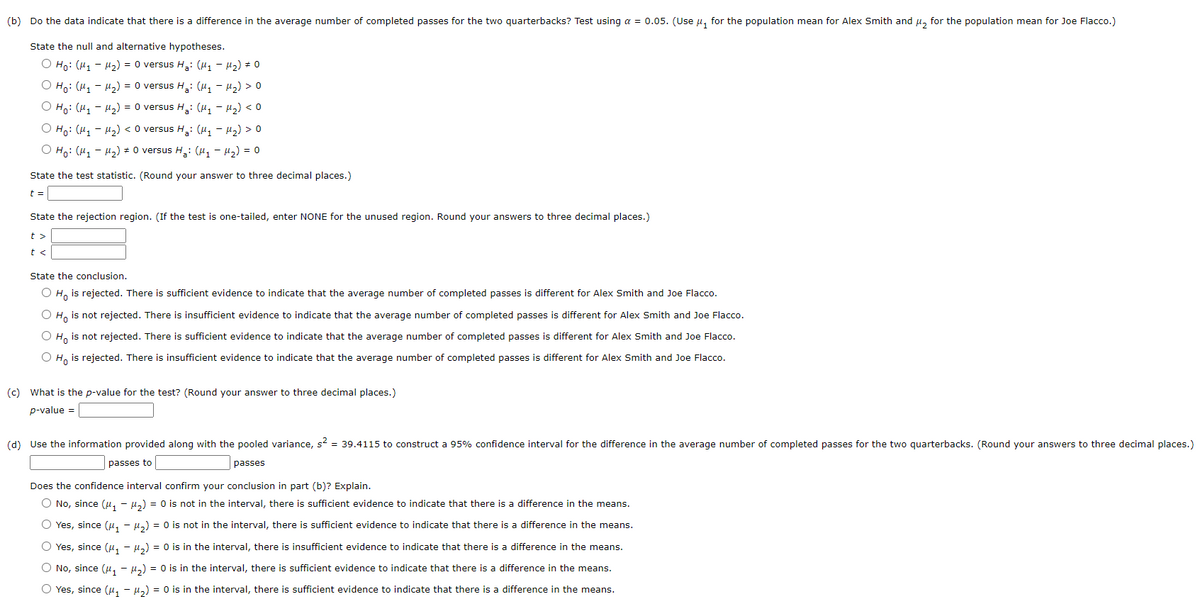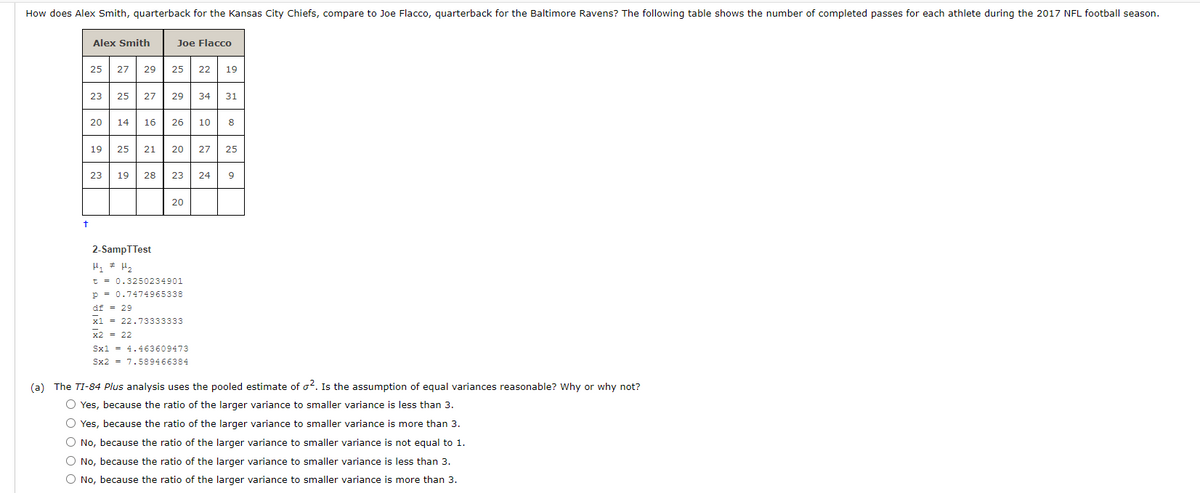Do the data indicate that there is a difference in the average number of completed passes for the two quarterbacks? Test using a = 0.05. (Use u, for the population mean for Alex Smith and u, for the population mean for Joe Flacco.) State the null and alternative hypotheses. O Ho: (H2 - H2) = 0 versus H: (H1 – H2) * 0 O Ho: (H, - H2) = 0 versus H: (Hq - H2) > 0 O Ho: (Hy- H2) = 0 versus H,: (H, - H2) < O O Ho: (Hy - H2) < 0 versus H,: (H, - H2) > 0 O Hạ: (Hy - H2) # 0 versus H,: (H, - H2) = 0 State the test statistic. (Round your answer to three decimal places.) State the rejection region. (If the test is one-tailed, enter NONE for the unused region. Round your answers to three decimal places.) t< State the conclusion. O H, is rejected. There is sufficient evidence to indicate that the average number of completed passes is different for Alex Smith and Joe Flacco. O Ho is not rejected. There insufficient evidence to indicate that the average number of completed passes is different for Alex Smith and Joe Flacco. O Ho is not rejected. There is sufficient evidence to indicate that the average number of completed passes is different for Alex Smith and Joe Flacco. O H, is rejected. There is insufficient evidence to indicate that the average number of completed passes is different for Alex Smith and Joe Flacco. What is the p-value for the test? (Round your answer to three decimal places.)
Do the data indicate that there is a difference in the average number of completed passes for the two quarterbacks? Test using a = 0.05. (Use u, for the population mean for Alex Smith and u, for the population mean for Joe Flacco.) State the null and alternative hypotheses. O Ho: (H2 - H2) = 0 versus H: (H1 – H2) * 0 O Ho: (H, - H2) = 0 versus H: (Hq - H2) > 0 O Ho: (Hy- H2) = 0 versus H,: (H, - H2) < O O Ho: (Hy - H2) < 0 versus H,: (H, - H2) > 0 O Hạ: (Hy - H2) # 0 versus H,: (H, - H2) = 0 State the test statistic. (Round your answer to three decimal places.) State the rejection region. (If the test is one-tailed, enter NONE for the unused region. Round your answers to three decimal places.) t< State the conclusion. O H, is rejected. There is sufficient evidence to indicate that the average number of completed passes is different for Alex Smith and Joe Flacco. O Ho is not rejected. There insufficient evidence to indicate that the average number of completed passes is different for Alex Smith and Joe Flacco. O Ho is not rejected. There is sufficient evidence to indicate that the average number of completed passes is different for Alex Smith and Joe Flacco. O H, is rejected. There is insufficient evidence to indicate that the average number of completed passes is different for Alex Smith and Joe Flacco. What is the p-value for the test? (Round your answer to three decimal places.)
Glencoe Algebra 1, Student Edition, 9780079039897, 0079039898, 2018
18th Edition
ISBN:9780079039897
Author:Carter
Publisher:Carter
Chapter10: Statistics
Section10.5: Comparing Sets Of Data
Problem 26PFA
Related questions
Question
9 this question has part a,b,c, and d

Transcribed Image Text:(b) Do the data indicate that there is a difference in the average number of completed passes for the two quarterbacks? Test using a = 0.05. (Use u, for the population mean for Alex Smith and µ, for the population mean for Joe Flacco.)
State the null and alternative hypotheses.
O Ho: (H1 - H2) = 0 versus H,: (H1 - H2) # 0
O Ho: (H, - H2) = 0 versus H: (H, - H2) > 0
O Ho: (H, - H2) = 0 versus H,: (H, - H2) < 0
O Ho: (H, - H2) < 0 versus H,: (H, - H2) > 0
О на: (и, - и,) + O versus H,: (u, - и) %3D о
State the test statistic. (Round your answer to three decimal places.)
t =
State the rejection region. (If the test is one-tailed, enter NONE for the unused region. Round your answers to three decimal places.)
t >
t <
State the conclusion.
O H, is rejected. There is sufficient evidence to indicate that the average number of completed passes is different for Alex Smith and Joe Flacco.
O H, is not rejected. There is insufficient evidence to indicate that the average number of completed passes is different for Alex Smith and Joe Flacco.
O H, is not rejected. There is sufficient evidence to indicate that the average number of completed passes is different for Alex Smith and Joe Flacco.
O H, is rejected. There is insufficient evidence to indicate that the average number of completed passes is different for Alex Smith and Joe Flacco.
(c) What is the p-value for the test? (Round your answer to three decimal places.)
p-value =
(d) Use the information provided along with the pooled variance, s? = 39.4115 to construct a 95% confidence interval for the difference in the average number of completed passes for the two quarterbacks. (Round your answers to three decimal places.)
passes to
|passes
Does the confidence interval confirm your conclusion in part (b)? Explain.
O No, since (u, - µ,) = 0 is not in the interval, there is sufficient evidence to indicate that there is a difference in the means.
O Yes, since (4, - µ,) = 0 is not in the interval, there is sufficient evidence to indicate that there is a difference in the means.
O Yes, since (u, - µ,) = 0 is in the interval, there is insufficient evidence to indicate that there is a difference in the means.
O No, since (u, - 4,) = 0 is in the interval, there is sufficient evidence to indicate that there is a difference in the means.
O Yes, since (u, - µ,) = 0 is in the interval, there is sufficient evidence to indicate that there is a difference in the means.

Transcribed Image Text:How does Alex Smith, quarterback for the Kansas City Chiefs, compare to Joe Flacco, quarterback for the Baltimore Ravens? The following table shows the number of completed passes for each athlete during the 2017 NFL football season.
Alex Smith
Joe Flacco
25
27
29
25
22
19
23
25
27
29
34
31
20
14
16 | 26
10
8
19
25
21
20
27
25
23
19
28
23
24
9
20
2-SampTTest
H1 * H2
t = 0.3250234901
p = 0.7474965338
df = 29
x1 = 22.73333333
x2 = 22
Sx1 = 4.463609473
Sx2 = 7.589466384
(a)
The TI-84 Plus analysis uses the pooled estimate of o?. Is the assumption of equal variances reasonable? Why or why not?
O Yes, because the ratio of the larger variance to smaller variance is less than 3.
O Yes, because the ratio of the larger variance to smaller variance is more than 3.
O No, because the ratio of the larger variance to smaller variance is not equal to 1.
O No, because the ratio of the larger variance to smaller variance is less than 3.
O No, because the ratio of the larger variance to smaller variance is more than 3.
Expert Solution
This question has been solved!
Explore an expertly crafted, step-by-step solution for a thorough understanding of key concepts.
Step by step
Solved in 2 steps with 1 images

Recommended textbooks for you

Glencoe Algebra 1, Student Edition, 9780079039897…
Algebra
ISBN:
9780079039897
Author:
Carter
Publisher:
McGraw Hill

Functions and Change: A Modeling Approach to Coll…
Algebra
ISBN:
9781337111348
Author:
Bruce Crauder, Benny Evans, Alan Noell
Publisher:
Cengage Learning

Big Ideas Math A Bridge To Success Algebra 1: Stu…
Algebra
ISBN:
9781680331141
Author:
HOUGHTON MIFFLIN HARCOURT
Publisher:
Houghton Mifflin Harcourt

Glencoe Algebra 1, Student Edition, 9780079039897…
Algebra
ISBN:
9780079039897
Author:
Carter
Publisher:
McGraw Hill

Functions and Change: A Modeling Approach to Coll…
Algebra
ISBN:
9781337111348
Author:
Bruce Crauder, Benny Evans, Alan Noell
Publisher:
Cengage Learning

Big Ideas Math A Bridge To Success Algebra 1: Stu…
Algebra
ISBN:
9781680331141
Author:
HOUGHTON MIFFLIN HARCOURT
Publisher:
Houghton Mifflin Harcourt

Holt Mcdougal Larson Pre-algebra: Student Edition…
Algebra
ISBN:
9780547587776
Author:
HOLT MCDOUGAL
Publisher:
HOLT MCDOUGAL